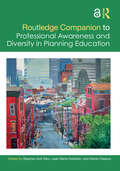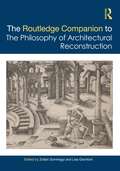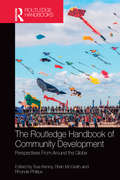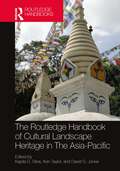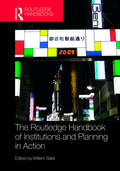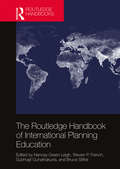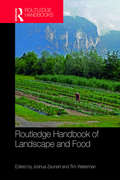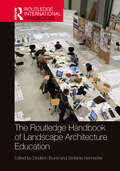- Table View
- List View
The Routledge Companion to Ecological Design Thinking: Healthful Ecotopian Visions for Architecture and Urbanism
by Mitra KanaaniThis companion investigates the ways in which designers, architects, and planners address ecology through the built environment by integrating ecological ideas and ecological thinking into discussions of urbanism, society, culture, and design. Exploring the innovation of materials, habitats, landscapes, and infrastructures, it furthers novel ecotopian ideas and ways of living, including human-made settings on water, in outer space, and in extreme environments and climatic conditions. Chapters of this extensive collection on ecotopian design are grouped under five different ecological perspectives: design manifestos and ecological theories, anthropocentric transformative design concepts, design connectivity, climatic design, and social design. Contributors provide plausible, sustainable design ideas that promote resiliency, health, and well-being for all living things, while taking our changing lifestyles into consideration. This volume encourages creative thinking in the face of ongoing environmental damage, with a view to making design decisions in the interest of the planet and its inhabitants. With contributions from over 79 expert practitioners, educators, scientists, researchers, and theoreticians, as well as planners, architects, and engineers from the U.S., Canada, Europe, and Asia, this book engages theory, history, technology, engineering, and science, as well as the human aspects of ecotopian design thinking and its implications for the outlook of the planet.
The Routledge Companion to Ecological Design Thinking: Healthful Ecotopian Visions for Architecture and Urbanism
by Mitra KanaaniThis companion investigates the ways in which designers, architects, and planners address ecology through the built environment by integrating ecological ideas and ecological thinking into discussions of urbanism, society, culture, and design. Exploring the innovation of materials, habitats, landscapes, and infrastructures, it furthers novel ecotopian ideas and ways of living, including human-made settings on water, in outer space, and in extreme environments and climatic conditions. Chapters of this extensive collection on ecotopian design are grouped under five different ecological perspectives: design manifestos and ecological theories, anthropocentric transformative design concepts, design connectivity, climatic design, and social design. Contributors provide plausible, sustainable design ideas that promote resiliency, health, and well-being for all living things, while taking our changing lifestyles into consideration. This volume encourages creative thinking in the face of ongoing environmental damage, with a view to making design decisions in the interest of the planet and its inhabitants. With contributions from over 79 expert practitioners, educators, scientists, researchers, and theoreticians, as well as planners, architects, and engineers from the U.S., Canada, Europe, and Asia, this book engages theory, history, technology, engineering, and science, as well as the human aspects of ecotopian design thinking and its implications for the outlook of the planet.
The Routledge Companion to Landscape Studies (Routledge International Handbooks)
by Peter Howard Ian Thompson Emma Waterton Mick AthaThis new edition of The Routledge Companion to Landscape Studies contains an updated and expanded selection of original chapters which explore research directions in an array of disciplines sharing a concern for ‘landscape’, a term which has many uses and meanings. It features 33 revised and/or updated chapters and 14 entirely new chapters on topics such as the Anthropocene, Indigenous landscapes, challenging landscape Eurocentrisms, photography and green infrastructure planning. The volume is divided into four parts: Experiencing landscape; Landscape, heritage and culture; Landscape, society and justice; and Design and planning for landscape. Collectively, the book provides a critical review of the various fields related to the study of landscapes, including the future development of conceptual and theoretical approaches, as well as current empirical knowledge and understanding. It encourages dialogue across disciplinary barriers and between academics and practitioners, and reflects upon the implications of research findings for local, national and international policy in relation to landscape. The Companion provides a comprehensive and up-to-date guide to current thinking about landscapes, and serves as an invaluable point of reference for scholars, researchers and graduate students alike.
The Routledge Companion to Landscape Studies (Routledge International Handbooks)
by Peter Howard Ian Thompson Emma Waterton Mick AthaThis new edition of The Routledge Companion to Landscape Studies contains an updated and expanded selection of original chapters which explore research directions in an array of disciplines sharing a concern for ‘landscape’, a term which has many uses and meanings. It features 33 revised and/or updated chapters and 14 entirely new chapters on topics such as the Anthropocene, Indigenous landscapes, challenging landscape Eurocentrisms, photography and green infrastructure planning. The volume is divided into four parts: Experiencing landscape; Landscape, heritage and culture; Landscape, society and justice; and Design and planning for landscape. Collectively, the book provides a critical review of the various fields related to the study of landscapes, including the future development of conceptual and theoretical approaches, as well as current empirical knowledge and understanding. It encourages dialogue across disciplinary barriers and between academics and practitioners, and reflects upon the implications of research findings for local, national and international policy in relation to landscape. The Companion provides a comprehensive and up-to-date guide to current thinking about landscapes, and serves as an invaluable point of reference for scholars, researchers and graduate students alike.
Routledge Companion to Professional Awareness and Diversity in Planning Education
by Stephen Kofi Diko Leah Marie Hollstein Danilo PalazzoThe Routledge Companion to Professional Awareness and Diversity in Planning Education engenders a discourse on how urban planning as a discipline is being made attractive to children and youth as they consider their career preferences. It also provides a discourse around the diversity challenges facing the institutions for training urban planning professionals.This Companion is an impressive collection of initiatives, experiences, and lessons in helping children, youth, and the general public appreciate the importance of, and the diversity challenge confronting, the urban planning profession and education. It comprises empirical, experimental, and case study research on initiatives to address the professional awareness and diversity challenges in urban planning. It has uniquely assembled voices and experiences from countries in Africa, Asia, Europe, and North America. Contributors are educators, practitioners, and activists of urban planning as well as policymakers in their respective countries.This Companion is intended as a resource for urban planning schools and departments, foundations, non-profit organizations, private sector organizations, public institutions, teachers, and alumni, among others to learn and consciously drive efforts to increase planning education awareness among children, youth, and the general public.Chapter 6 of this book is freely available as a downloadable Open Access PDF at http://www.taylorfrancis.com under a Creative Commons Attribution-Non Commercial-No Derivatives (CC-BY-NC-ND) 4.0 license.
Routledge Companion to Professional Awareness and Diversity in Planning Education
The Routledge Companion to Professional Awareness and Diversity in Planning Education engenders a discourse on how urban planning as a discipline is being made attractive to children and youth as they consider their career preferences. It also provides a discourse around the diversity challenges facing the institutions for training urban planning professionals.This Companion is an impressive collection of initiatives, experiences, and lessons in helping children, youth, and the general public appreciate the importance of, and the diversity challenge confronting, the urban planning profession and education. It comprises empirical, experimental, and case study research on initiatives to address the professional awareness and diversity challenges in urban planning. It has uniquely assembled voices and experiences from countries in Africa, Asia, Europe, and North America. Contributors are educators, practitioners, and activists of urban planning as well as policymakers in their respective countries.This Companion is intended as a resource for urban planning schools and departments, foundations, non-profit organizations, private sector organizations, public institutions, teachers, and alumni, among others to learn and consciously drive efforts to increase planning education awareness among children, youth, and the general public.Chapter 6 of this book is freely available as a downloadable Open Access PDF at http://www.taylorfrancis.com under a Creative Commons Attribution-Non Commercial-No Derivatives (CC-BY-NC-ND) 4.0 license.
The Routledge Companion to the Philosophy of Architectural Reconstruction
by Lisa Giombini Zoltán SomhegyiThis companion investigates the philosophical and theoretical foundations determining the conditions of possibility and the limits that make the conservation, readaptation, and transformation of past buildings legitimate operations.As increasing ecological and economic challenges question opportunities for new construction, the process of restoring, transforming, and readapting buildings for new or continued use is becoming an essential part of architectural practice. At the same time, the role of building conservation is changing from mere material preservation to being part of a broader strategy for social regeneration, eco-awareness, and inclusive urban planning. Chapters of this volume explore the complex set of considerations that inform decisions to merely preserve, accurately restore or variously reuse a building. They also look at the broader philosophical concerns such as ethical and aesthetic values, combined with ideas of heritage, history, and collective identity. Case studies on reconstruction after war, gentrification, the restoration of ancient edifices, reconstruction following the effects of climate change, and the use of technology solutions among many others, make this a timely and urgent volume.Adopting a broad transcultural perspective with contributions from five continents, the volume combines theoretical approaches with more practical, case study-based investigations and will be of great interest to upper-level students and academics working in the fields of architecture, conservation, urban design, aesthetics, and heritage management.
The Routledge Companion to the Philosophy of Architectural Reconstruction
This companion investigates the philosophical and theoretical foundations determining the conditions of possibility and the limits that make the conservation, readaptation, and transformation of past buildings legitimate operations.As increasing ecological and economic challenges question opportunities for new construction, the process of restoring, transforming, and readapting buildings for new or continued use is becoming an essential part of architectural practice. At the same time, the role of building conservation is changing from mere material preservation to being part of a broader strategy for social regeneration, eco-awareness, and inclusive urban planning. Chapters of this volume explore the complex set of considerations that inform decisions to merely preserve, accurately restore or variously reuse a building. They also look at the broader philosophical concerns such as ethical and aesthetic values, combined with ideas of heritage, history, and collective identity. Case studies on reconstruction after war, gentrification, the restoration of ancient edifices, reconstruction following the effects of climate change, and the use of technology solutions among many others, make this a timely and urgent volume.Adopting a broad transcultural perspective with contributions from five continents, the volume combines theoretical approaches with more practical, case study-based investigations and will be of great interest to upper-level students and academics working in the fields of architecture, conservation, urban design, aesthetics, and heritage management.
The Routledge Handbook of Community Development: Perspectives from Around the Globe
by Sue Kenny Brian McGrath Rhonda PhillipsThe Routledge Handbook of Community Development explores community development theory and practice across the world. The book provides perspectives about community development as an interactive, relevant and sometimes contradictory way to address issues impacting the human condition. It promotes better understanding of the complexities and challenges in identifying, designing, implementing and evaluating community development constructs, applications and interventions. This edited volume discusses how community development is conceptualized as an approach, method or profession. Themes provide the scope of the book, with projects, issues or perspectives presented in each of these areas. This handbook provides invaluable contextualized insights on the theory and practice of community development around core themes relevant in society. Each chapter explores and presents an issue, perspectives, project or case in the thematic areas, with regional and country context included. It is a must-read for students and researchers working in community development, planning and human geography and an essential reference for any professional engaged in community development.
The Routledge Handbook of Community Development: Perspectives from Around the Globe
by Rhonda Phillips Sue Kenny Brian McGrathThe Routledge Handbook of Community Development explores community development theory and practice across the world. The book provides perspectives about community development as an interactive, relevant and sometimes contradictory way to address issues impacting the human condition. It promotes better understanding of the complexities and challenges in identifying, designing, implementing and evaluating community development constructs, applications and interventions. This edited volume discusses how community development is conceptualized as an approach, method or profession. Themes provide the scope of the book, with projects, issues or perspectives presented in each of these areas. This handbook provides invaluable contextualized insights on the theory and practice of community development around core themes relevant in society. Each chapter explores and presents an issue, perspectives, project or case in the thematic areas, with regional and country context included. It is a must-read for students and researchers working in community development, planning and human geography and an essential reference for any professional engaged in community development.
The Routledge Handbook of Cultural Landscape Heritage in The Asia-Pacific (Routledge Handbooks on Museums, Galleries and Heritage)
by Kapila D. Silva Ken Taylor David S. JonesThe Routledge Handbook of Cultural Landscape Heritage in the Asia-Pacific revisits the use, growth, and potential of the cultural landscape methodology in the conservation and management of culture-nature heritage in the Asia-Pacific region. Taking both a retrospective and prospective view of the management of cultural heritage in the region, this volume argues that the plurality and complexity of heritage in the region cannot be comprehensively understood and effectively managed without a broader conceptual framework like the cultural landscape approach. The book also demonstrates that such an approach facilitates the development of a flexible strategy for heritage conservation. Acknowledging the effects of rapid socio-economic development, globalization, and climate change, contributors examine the pressure these issues place on the sustenance of cultural heritage. Including chapters from more than 20 countries across the Asia-Pacific region, the volume reviews the effectiveness of theoretical and practical potentials afforded by the cultural landscape approach and examines how they have been utilized in the Asia-Pacific context for the last three decades. The Routledge Handbook of Cultural Landscape Heritage in the Asia-Pacific provides a comprehensive analysis of the processes of cultural landscape heritage conservation and management. As a result, it will be of interest to academics, students, and professionals who are based in the fields of cultural heritage management, architecture, urban planning, landscape architecture, and landscape management.
The Routledge Handbook of Cultural Landscape Heritage in The Asia-Pacific (Routledge Handbooks on Museums, Galleries and Heritage)
by Ken Taylor David S. Jones Kapila D. SilvaThe Routledge Handbook of Cultural Landscape Heritage in the Asia-Pacific revisits the use, growth, and potential of the cultural landscape methodology in the conservation and management of culture-nature heritage in the Asia-Pacific region. Taking both a retrospective and prospective view of the management of cultural heritage in the region, this volume argues that the plurality and complexity of heritage in the region cannot be comprehensively understood and effectively managed without a broader conceptual framework like the cultural landscape approach. The book also demonstrates that such an approach facilitates the development of a flexible strategy for heritage conservation. Acknowledging the effects of rapid socio-economic development, globalization, and climate change, contributors examine the pressure these issues place on the sustenance of cultural heritage. Including chapters from more than 20 countries across the Asia-Pacific region, the volume reviews the effectiveness of theoretical and practical potentials afforded by the cultural landscape approach and examines how they have been utilized in the Asia-Pacific context for the last three decades. The Routledge Handbook of Cultural Landscape Heritage in the Asia-Pacific provides a comprehensive analysis of the processes of cultural landscape heritage conservation and management. As a result, it will be of interest to academics, students, and professionals who are based in the fields of cultural heritage management, architecture, urban planning, landscape architecture, and landscape management.
Routledge Handbook of Cultural Landscape Practice (Routledge International Handbooks)
by Steve Brown Cari GoetcheusCultural landscapes, which in the field of heritage studies and practice relates to caring for and safeguarding heritage landscapes, is a concept embedded in contemporary conservation. Heritage conservation has shifted from an historical focus on buildings, city centres, and archaeological sites to encompass progressively more diverse forms of heritage and increasingly larger geographic areas, embracing both rural and urban landscapes. While the origin of the idea of cultural landscapes can be traced to the late-19th century Euro-American scholarship, it came to global attention after 1992 following its adoption as a category of ‘site’ by the UNESCO World Heritage Committee. Today, cultural landscape practice has become increasingly complex given the expansion of the values and meanings of heritage, the influence of environmental challenges such as human induced climate change, technological advancements, and the need to better understand and interpret human connections to place and landscapes. The aim of this handbook is to strike a balance between theory and practice, which we see as inseparable, while also seeking to achieve a geographical spread, disciplinary diversity and perspectives, and a mix of authors from academic, practitioner, management, and community backgrounds.
Routledge Handbook of Cultural Landscape Practice (Routledge International Handbooks)
by Steve Brown Cari GoetcheusCultural landscapes, which in the field of heritage studies and practice relates to caring for and safeguarding heritage landscapes, is a concept embedded in contemporary conservation. Heritage conservation has shifted from an historical focus on buildings, city centres, and archaeological sites to encompass progressively more diverse forms of heritage and increasingly larger geographic areas, embracing both rural and urban landscapes. While the origin of the idea of cultural landscapes can be traced to the late-19th century Euro-American scholarship, it came to global attention after 1992 following its adoption as a category of ‘site’ by the UNESCO World Heritage Committee. Today, cultural landscape practice has become increasingly complex given the expansion of the values and meanings of heritage, the influence of environmental challenges such as human induced climate change, technological advancements, and the need to better understand and interpret human connections to place and landscapes. The aim of this handbook is to strike a balance between theory and practice, which we see as inseparable, while also seeking to achieve a geographical spread, disciplinary diversity and perspectives, and a mix of authors from academic, practitioner, management, and community backgrounds.
Routledge Handbook of High-Performance Workplaces (Transdisciplinary Workplace Research and Management)
by Christhina Candido Iva Durakovic Samin MarzbanThis timely book focuses on an overview of the fundamentals behind high-performance workplaces underpinning occupants’ satisfaction, health, and productivity. To this end, it covers human, environmental, and organisational aspects proven to be of great relevance to the design of high-performance workplaces. Perhaps most significantly it looks at these characteristics both before and after the start of the COVID-19 pandemic. From the exodus from private offices to the rise of open-plan workplaces, where, how and when people work was changing rapidly pre-COVID. Post-COVID, pandemic-imposed restrictions banished workers from offices into their homes fast, leaving organisation scrambling to keep workers functioning away from HQ. After the immediate shockwaves set by the pandemic, workers and organisations have had the time to learn about positives and negative aspects of remote working with the vast majority now questioning the need to go back to HQ and the purpose of offices. In this book, the contributors share and discuss lessons learned from research conducted in workplaces pre- and post-2020 with a view of providing a clear picture about what high-performance workplaces are about, including the key drivers behind workers’ satisfaction, health, and productivity. This handbook builds on a programme of applied research conducted in workplaces led by the editors over the last decade which is aimed at understanding the synergies between the design, performance, and experience of spaces. It examines ergonomics, biophilic design, acoustics, indoor air quality, thermal comfort, diversity, leadership, psychological safety, culture, and much more. Research findings are presented side-by-side with case studies selected from the research database led by the editors. Industry experts add to the academic voice, reinforcing the authenticity of this book and its relevance to other stakeholders found outside the academic arena, including the property and design industry, students, government, and the community in general.The Open Access version of this book, available at http://www.taylorfrancis.com, has been made available under a Creative Commons Attribution-Non Commercial-No Derivatives (CC-BY-NC-ND) 4.0 license.
Routledge Handbook of High-Performance Workplaces (Transdisciplinary Workplace Research and Management)
This timely book focuses on an overview of the fundamentals behind high-performance workplaces underpinning occupants’ satisfaction, health, and productivity. To this end, it covers human, environmental, and organisational aspects proven to be of great relevance to the design of high-performance workplaces. Perhaps most significantly it looks at these characteristics both before and after the start of the COVID-19 pandemic. From the exodus from private offices to the rise of open-plan workplaces, where, how and when people work was changing rapidly pre-COVID. Post-COVID, pandemic-imposed restrictions banished workers from offices into their homes fast, leaving organisation scrambling to keep workers functioning away from HQ. After the immediate shockwaves set by the pandemic, workers and organisations have had the time to learn about positives and negative aspects of remote working with the vast majority now questioning the need to go back to HQ and the purpose of offices. In this book, the contributors share and discuss lessons learned from research conducted in workplaces pre- and post-2020 with a view of providing a clear picture about what high-performance workplaces are about, including the key drivers behind workers’ satisfaction, health, and productivity. This handbook builds on a programme of applied research conducted in workplaces led by the editors over the last decade which is aimed at understanding the synergies between the design, performance, and experience of spaces. It examines ergonomics, biophilic design, acoustics, indoor air quality, thermal comfort, diversity, leadership, psychological safety, culture, and much more. Research findings are presented side-by-side with case studies selected from the research database led by the editors. Industry experts add to the academic voice, reinforcing the authenticity of this book and its relevance to other stakeholders found outside the academic arena, including the property and design industry, students, government, and the community in general.The Open Access version of this book, available at http://www.taylorfrancis.com, has been made available under a Creative Commons Attribution-Non Commercial-No Derivatives (CC-BY-NC-ND) 4.0 license.
The Routledge Handbook of Institutions and Planning in Action
by Willem SaletThe Routledge Handbook of Institutions and Planning in Action contains a selection of 25 chapters prepared by specialized international scholars of urban planning and urban studies focusing on the question of how institutional innovation occurs in practices of action. The contributors share expertise on institutional innovation and philosophical pragmatism. They discuss the different facets of these two conceptual frameworks and explore the alternative combinations through which they can be approached. The relevance of these conceptual lines of thought will be exemplified in exploring the contemporary practices of sustainable (climate-proof) urban transition. The aim of the handbook is to give a boost to the turn of institutional analysis in the context of action in changing cities. Both philosophical pragmatism and institutional innovation rest on wide international uses in social sciences and planning studies, and may be considered as complementary for many reasons. However, the combination of these different approaches is all but evident and creates a number of dilemmas. After an encompassing introductory section entitled Institutions in Action, the handbook is further divided into the following sections: Institutional innovation Pragmatism: The Dimension of Action On Justification Cultural and Political Institutions in Action Institutions and Urban Transition
The Routledge Handbook of Institutions and Planning in Action
by Willem SaletThe Routledge Handbook of Institutions and Planning in Action contains a selection of 25 chapters prepared by specialized international scholars of urban planning and urban studies focusing on the question of how institutional innovation occurs in practices of action. The contributors share expertise on institutional innovation and philosophical pragmatism. They discuss the different facets of these two conceptual frameworks and explore the alternative combinations through which they can be approached. The relevance of these conceptual lines of thought will be exemplified in exploring the contemporary practices of sustainable (climate-proof) urban transition. The aim of the handbook is to give a boost to the turn of institutional analysis in the context of action in changing cities. Both philosophical pragmatism and institutional innovation rest on wide international uses in social sciences and planning studies, and may be considered as complementary for many reasons. However, the combination of these different approaches is all but evident and creates a number of dilemmas. After an encompassing introductory section entitled Institutions in Action, the handbook is further divided into the following sections: Institutional innovation Pragmatism: The Dimension of Action On Justification Cultural and Political Institutions in Action Institutions and Urban Transition
The Routledge Handbook of International Planning Education
by Nancey Green Leigh Steven P. French Subhrajit Guhathakurta Bruce StiftelThe Routledge Handbook of International Planning Education is the first comprehensive handbook with a unique focus on planning education. Comparing approaches to the delivery of planning education by three major planning education accreditation bodies in the United States, Australia, and the United Kingdom, and reflecting concerns from other national planning systems, this handbook will help to meet the strong interest and need for understanding how planning education is developed and delivered in different international contexts. The handbook is divided into five major sections, including coverage of general planning knowledge, planning skills, traditional and emerging planning specializations, and pedagogy. An international cohort of contributors covers each subject’s role in educating planners, its theory and methods, key literature contributions, and course design. Higher education’s response to globalization has included growth in planning educational exchanges across international boundaries; The Routledge Handbook of International Planning Education is an essential resource for planners and planning educators, informing the dialogue on the mobility of planners educated under different national schema.
The Routledge Handbook of International Planning Education
The Routledge Handbook of International Planning Education is the first comprehensive handbook with a unique focus on planning education. Comparing approaches to the delivery of planning education by three major planning education accreditation bodies in the United States, Australia, and the United Kingdom, and reflecting concerns from other national planning systems, this handbook will help to meet the strong interest and need for understanding how planning education is developed and delivered in different international contexts. The handbook is divided into five major sections, including coverage of general planning knowledge, planning skills, traditional and emerging planning specializations, and pedagogy. An international cohort of contributors covers each subject’s role in educating planners, its theory and methods, key literature contributions, and course design. Higher education’s response to globalization has included growth in planning educational exchanges across international boundaries; The Routledge Handbook of International Planning Education is an essential resource for planners and planning educators, informing the dialogue on the mobility of planners educated under different national schema.
Routledge Handbook of Landscape and Food
by Joshua Zeunert Tim WatermanSince the turn of the millennium, there has been a burgeoning interest in, and literature of, both landscape studies and food studies. Landscape describes places as relationships and processes. Landscapes create people’s identities and guide their actions and their preferences, while at the same time are shaped by the actions and forces of people. Food, as currency, medium, and sustenance, is a fundamental part of those landscape relationships. This volume brings together over fifty contributors from around the world in forty profoundly interdisciplinary chapters. Chapter authors represent an astonishing range of disciplines, from agronomy, anthropology, archaeology, conservation, countryside management, cultural studies, ecology, ethics, geography, heritage studies, landscape architecture, landscape management and planning, literature, urban design and architecture. Both food studies and landscape studies defy comprehension from the perspective of a single discipline, and thus such a range is both necessary and enriching. The Routledge Handbook of Landscape and Food is intended as a first port of call for scholars and researchers seeking to undertake new work at the many intersections of landscape and food. Each chapter provides an authoritative overview, a broad range of pertinent readings and references, and seeks to identify areas where new research is needed—though these may also be identified in the many fertile areas in which subjects and chapters overlap within the book.
Routledge Handbook of Landscape and Food
by Joshua Zeunert Tim WatermanSince the turn of the millennium, there has been a burgeoning interest in, and literature of, both landscape studies and food studies. Landscape describes places as relationships and processes. Landscapes create people’s identities and guide their actions and their preferences, while at the same time are shaped by the actions and forces of people. Food, as currency, medium, and sustenance, is a fundamental part of those landscape relationships. This volume brings together over fifty contributors from around the world in forty profoundly interdisciplinary chapters. Chapter authors represent an astonishing range of disciplines, from agronomy, anthropology, archaeology, conservation, countryside management, cultural studies, ecology, ethics, geography, heritage studies, landscape architecture, landscape management and planning, literature, urban design and architecture. Both food studies and landscape studies defy comprehension from the perspective of a single discipline, and thus such a range is both necessary and enriching. The Routledge Handbook of Landscape and Food is intended as a first port of call for scholars and researchers seeking to undertake new work at the many intersections of landscape and food. Each chapter provides an authoritative overview, a broad range of pertinent readings and references, and seeks to identify areas where new research is needed—though these may also be identified in the many fertile areas in which subjects and chapters overlap within the book.
The Routledge Handbook of Landscape Architecture Education (Routledge International Handbooks)
by Diedrich Bruns Stefanie HenneckeIn this handbook, 60 authors, senior and junior educators, and researchers from six continents provide an overview of 200 years of landscape architectural education. They tell the stories of schools and people, of visions, and of experiments that constitute landscape architecture education heritage. Through taking an international perspective, the handbook centers inclusivity with an appreciation for how education develops in different political and societal contexts. Part I introduces the field of education history research, including research approaches and international research exchange. Spanning more than 100 years, Parts II and III investigate and compare early and recent histories of landscape architecture education in different countries and schools. In Part IV, the book offers new perspectives for landscape architecture education. Education research presents a substantial opportunity for challenging studies to increase the pedagogic and didactic, the academic and historic, and the disciplinary knowledge basis. Through a boundary-crossing approach, these studies about landscape architecture education provide a reference to teachers and students, policymakers, and administrators, who strive for innovative, holistic, and interdisciplinary practice.
The Routledge Handbook of Landscape Architecture Education (Routledge International Handbooks)
by Diedrich Bruns Stefanie HenneckeIn this handbook, 60 authors, senior and junior educators, and researchers from six continents provide an overview of 200 years of landscape architectural education. They tell the stories of schools and people, of visions, and of experiments that constitute landscape architecture education heritage. Through taking an international perspective, the handbook centers inclusivity with an appreciation for how education develops in different political and societal contexts. Part I introduces the field of education history research, including research approaches and international research exchange. Spanning more than 100 years, Parts II and III investigate and compare early and recent histories of landscape architecture education in different countries and schools. In Part IV, the book offers new perspectives for landscape architecture education. Education research presents a substantial opportunity for challenging studies to increase the pedagogic and didactic, the academic and historic, and the disciplinary knowledge basis. Through a boundary-crossing approach, these studies about landscape architecture education provide a reference to teachers and students, policymakers, and administrators, who strive for innovative, holistic, and interdisciplinary practice.
Routledge Handbook of Landscape Character Assessment: Current Approaches to Characterisation and Assessment
by Graham Fairclough Ingrid Sarlöv Herlin Carys SwanwickIn this multi-authored book, senior practitioners and researchers offer an international overview of landscape character approaches for those working in research, policy and practice relating to landscape. Over the last three decades, European practice in landscape has moved from a narrow, if relatively straightforward, focus on natural beauty or scenery to a much broader concept of landscape character constructed through human perception, and transcending any of its individual elements. Methods, tools and techniques have been developed to give practical meaning to this idea of landscape character. The two main methods, Landscape Character Assessment (LCA) and Historic Landscape Characterisation (HLC) were applied first in the United Kingdom, but other methods are in use elsewhere in Europe, and beyond, to achieve similar ends. This book explores why different approaches exist, the extent to which disciplinary or cultural specificities in different countries affect approaches to land management and landscape planning, and highlights areas for reciprocal learning and knowledge transfer. Contributors to the book focus on examples of European countries – such as Sweden, Turkey and Portugal – that have adopted and extended UK-style landscape characterisation, but also on countries with their own distinctive approaches that have developed from different conceptual roots, as in Germany, France and the Netherlands. The collection is completed by chapters looking at landscape approaches based on non-European concepts of landscape in North America, Australia and New Zealand. This book has an introductory price of £125/$205 which will last until 3 months after publication - after this time it will revert to £140/$225.


